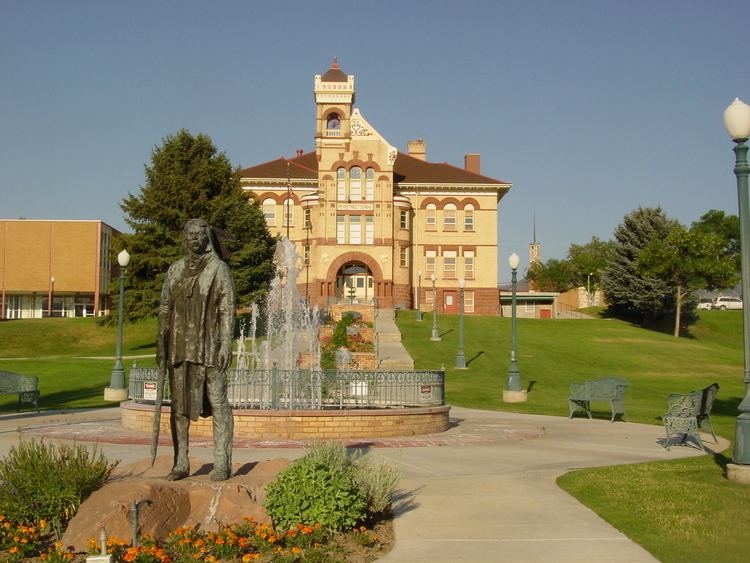NRHP Reference # 90000795 Architectural style Romanesque architecture | Area 2 ha Added to NRHP 2 April 1990 | |
 | ||
Similar Peteetneet Academy & Museum, Wasatch Range, Memorial Park, Woodbury Art Museum, Provo Pioneer Museum | ||
The Peteetneet Museum and Cultural Arts Center, located in Payson, Utah, is named after Chief Peteetneet, the indigenous clan leader of a Tumpanawach (Timpanogos) Ute band. It serves multiple civic purposes. The building houses a Daughters of the Utah Pioneers museum of pioneer artifacts, the Payson Historical Society, and the Peteetneet Arts Council as well as many community art and dance classes and events. The large hill behind the school is a popular place for watersliding in the summer and sledding in the winter.
Contents
Historic building
Prior to serving as a museum and cultural arts center, the Peteetneet School or Peteetneet Academy was erected in 1901. The architectural design combines both Victorian and Romanesque Revival architecture and was done by Richard C. Watkins, who designed many other schools through Utah and Sanpete counties. The Victorian belfry makes this school more flamboyant than other prominent schools designed by Watkins such as the Maeser School or Old Spring City School. The building served as an academy and then elementary school until 1989 when Payson City planned to demolish the building. A group of concerned citizens formed People Preserving Peteetneet and were instrumental in saving and restoring the school. Since the building is located on the Nebo Loop Scenic Byway, the Utah Department of Transportation awarded over $100,000 to assist in the restoration. The building was transformed into a museum and civic center. A glass elevator was added in 2008. The building has been listed on the National Register of Historic Places since May 30, 1990.
Peteetneet
Chief Peteetneet, or more precicely Pah-ti't-ni't (pronounced Paw-tee't-nee't), is the name of a clan leader in the Tumpanawach (Timpanogos) band of Utes, whose daughter Pomona (Pamamaci = "Water-woman") married the mountain man, Miles Goodyear. Peteetneet is the aglicized corruption of Pah-ti't-ni't in the Tumpanawach dialect of the Southern Paiute language, which means "Our Water Place".
The local indigenous clan leader, Ute Chief Peteetneet, lived near Peteetneet Creek, which was named for him (or perhaps for which he was named), in what is now known as Payson, Utah. Chief Peteetneet was not hostile to Mormon settlers who arrived in the area of his village in late autumn and early winter of 1850.
In February of 1850, his village was attacked by the Mormon militia, as part of the Battle at Fort Utah. While he was not there, he did confront the soldiers at Fort Utah after finding the bodies of several decapitated Indians.
When those first families arrived on Peteeneet Creek in late October, 1850, they found that Chief Peteetneet was friendly along with his band of about 200 Tumpanawach Utes, who already lived there in semi-permanent, grass-thatched, wattle-and-daub houses. The Mormon pioneers settled on an uninhabited section of the creek about a mile southeast of Peteetneet's village. It is unlikely that the settlement on Peteetneet Creek would have survived the winter without the benevolence of Chief Peteetneet and his band.
Chief Peteetneet also enjoyed the support of Mormon leaders in the Indian slave trade. Apostle George A. Smith gave him talking papers that certified "it is my desire that they [Captain Walker and Peteetneet] should be treated as friends, and as they wish to Trade horses, Buckskins and Piede children, we hope them success and prosperity and good bargains."
Chief Peteetneet died on December 23, 1861, under somewhat mysterious circumstances in Cedar Valley, Utah, near recently abandoned Fort Crittenden (Camp Floyd). He was buried on the mountainside in Cedar Valley by members of his band. His wife, who was murdered on his express deathbed orders by an axe-wielding woman in his band, was buried in the valley below his grave to accompany him into the afterlife. He was succeeded at his death in 1862 by a near kinsman named Ponnewats, a corruption of Pa-ni-wa-tsi, a name meaning "Little Master of Our Water",.
A monument of Chief Peteetneet stands at the front of the Peteetneet Museum and Cultural Arts Center.
